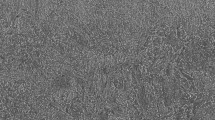Abstract
The enhancements in the storage systems developed by thermo solar centrals have provided to renewable energy a considerable increase in efficiency. This improvement also fosters the design of innovative storage fluids with lower melting point and thermal stability as new molten salts mixtures. In this research, the corrosive effects of a molten nitrate mixture composed by Ca(NO3)2–NaNO3–KNO3–LiNO3 were assessed at 390 °C on a carbon steel (A516) and on low-Cr alloy steels (T11 and T22). The corrosion rates were determined by gravimetric tests, measuring the weight gain during 2,000 h, identifying the corrosion products via scanning electron microscopy and X-ray diffraction. Study of T22 steel revealed a better behavior under corrosive environment, identifying the formation of MgCr2O4 protective spinels mainly. Fe2O3 and Fe3O4 were the others important products found on the tests performed at 390 °C, being observed also the formation of some stable compounds with the impurities of the salt, as carbonates and sulphates.















Similar content being viewed by others
References
J. Burgaleta, SENER and Torresol Energy win U.S. CSP Today awards. Renewable Energy Focus 12, (4), 12 (2010).
G. J. Kolb, Economic evaluation of solar-only and hybrid power towers using molten-salt technology. Solar Energy 62, (1), 51–61 (1998).
R. W. Bradshaw and S. Goods, Corrosion of alloys and metals by molten nitrates. Molten Salt Forum 7, 117–134 (2003).
S. H. Goods and R. W. Bradshaw, Corrosion of stainless steels and carbon steel by molten mixtures of commercial nitrate salts. Journal of Materials Engineering and Performance 13, 78–87 (2003).
S. H. Goods and R. W. Bradshaw, Constant extension rate testing of IN625LCF in molten nitrate salt. Corrosion Science 41, (6), 1119–1137 (1999).
I. B. Singh and U. Sen, Influence of temperature and sulphate ion on corrosion of mild steel in molten NaNO3. British Corrosion Journal 27, (4), 299–304 (1992).
S. H. Goods, Crack tip oxidation of a superalloy in molten nitrate salt. Scripta Metallurgica 17, (4), 533–536 (1983).
S. H. Goods, The effect of a molten nitrate salt environment on the mechanical properties of INCOLOY Alloy 800. Journal of Materials for Energy Systems 5, (1), 28–35 (1983).
S. A. Bradford, Corrosion, in ASM Handbook, ed. by J. Davis (Technology and Engineering, Metals Park, 1987).
R. A. Rapp, Hot corrosion of materials: a fluxing mechanism? Corrosion Science 44, (2), 209–221 (2002).
A. Baraka, A. I. Abdel-Rohman and A. A. El Hosary, Corrosion on mild steel in molten sodium nitrate-potassium nitrate eutectic. British Corrosion Journal 11, (1), 43–46 (1976).
J. M. De Jong and G. H. J. Broers, A reversible oxygen electrode in an equimolar KNO3–NaNO3 melt saturated with sodium peroxide II. A voltammetric study. Electrochimica Acta 21, (11), 893–900 (1976).
I. B. Singh, The effect of NaCl addition on the corrosion of mild steel in NaNO3 Melt. Corrosion Science 34, (10), 1733–1742 (1993).
F. Palmisano, Catalytic currents in fused salts: discharge mechanism of nitrite in molten alkali nitrates(II). Journal of Electroanalytical Chemistry and Interfacial Electrochemistry 89, (2), 311–320 (1978).
E. Desimoni, F. Palmisano and P. G. Zambonin, Catalytic currents in fused salts: discharge mechanism of nitrite in molten alkali nitrates. Journal of Electroanalytical Chemistry and Interfacial Electrochemistry 84, (2), 315–322 (1977).
P. G. Zambonin, V. L. Cardetta and G. Signorile, Solubility and detection of water in the (Na, K)NO3 eutectic melt. Journal of Electroanalytical Chemistry and Interfacial Electrochemistry 28, (2), 237–243 (1970).
I. B. Singh, The influence of moisture on the oxidation rate of iron in NaNO3 and KNO3 melts. Corrosion Science 37, (12), 1981–1989 (1995).
A. G. Fernández, Development of new molten salts with LiNO3 and Ca(NO3)2 for energy storage in CSP plants. Applied Energy 119, 131–140 (2014).
D. Kearney, U. Herrmann, P. Nava, B. Kelly and R. Mahoney, Assessment of a molten salt heat transfer fluid in a parabolic trough solar field. Journal of Solar Energy Engineering 125, (2), 170 (2003).
H. A. Abdel-Hakim, A. A. Attia and A. M. Baraka, Dissolution susceptibility of the oxide species formed on mild steel during its oxidation in molten NaNO3-KNO3 eutectic mixture. Journal of Materials Engineering and Performance 11, (3), 301–305 (2002).
A. J. Arvia, J. J. Podesta, and R. C. Piatti, Electrochimica Acta 17, 33 (1972), 16, 1997 (1971).
P. Spiteri, Electricite de France, EDF Report D 554/MAT, 1984, p. 40.
H. Fernandez, J. M. Carter, and R. A. Osteryoung, Proceedings of the 6th International Symposium on “Molten Salts,” The Electrochemical Society, Pennington, NJ, 1984.
M. Zimnol, et al., Structure and morphology of MgFe2O4 epitaxial films formed by solid state reactions on MgO(100) surfaces. Solid State Ionics 101–103 Part 2(0), 667–672 (1997).
A. Fernández, M. Lasanta and F. Pérez, Molten salt corrosion of stainless steels and low-Cr steel in CSP plants. Oxidation of Metals 78, 329–348 (2012).
Author information
Authors and Affiliations
Corresponding author
Rights and permissions
About this article
Cite this article
Fernández, A.G., Galleguillos, H. & Pérez, F.J. Corrosion Ability of a Novel Heat Transfer Fluid for Energy Storage in CSP Plants. Oxid Met 82, 331–345 (2014). https://doi.org/10.1007/s11085-014-9494-3
Received:
Revised:
Published:
Issue Date:
DOI: https://doi.org/10.1007/s11085-014-9494-3




